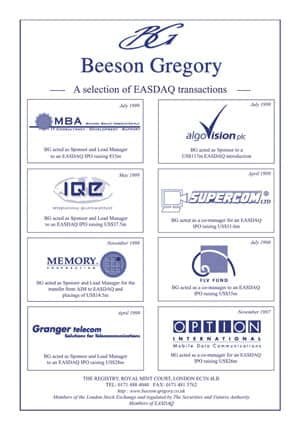
It was the European Commission that first coined the term ‘small and medium enterprise’ (SME) to describe businesses which employ less than 500 workers.
This case study focuses upon the role of Beeson Gregory, a City based corporate adviser and stockbroker, which specialises in serving the needs of entrepreneurial and growing companies within the SME sector. The study examines the source of finance and the way SMEs find access to it.
Beeson Gregory is a service driven business providing solutions tailored to the needs of its individual clients. In recent years, it has benefited from its niche position as adviser to European small and medium sized growth companies. The firm’s objective is to inform small and medium sized European companies on all aspects of corporate advice. Beeson Gregory’s key areas of expertise are divided into:
- Corporate advice – Beeson Gregory provides advice on various forms of finance, including floating companies on the stock market through offering shares to the public, as well as secondary issues i.e. providing further finance to existing public companies. Advice is also provided on buying and selling companies through acquisitions, disposals, take-overs and mergers.
- Broking – The Beeson Gregory team provides a range of stockbroking services that includes identifying clients’ investment requirements, opportunities for investment and maintaining a regular flow of information between the company and investors.
- Market-making – Market-making involves finding buyers and sellers for corporate stocks and shares. Beeson Gregory acts as market-maker for clients on the central securities market of the London Stock Exchange (known as the official list), the Alternative Investment Market (AIM – the market for firms that are too young or too small to be quoted on the full exchange), as well as EASDAQ (the European Association of Securities Dealers Automated Quotation – a pan- European market for medium-sized technology companies).
The importance of SMEs is now recognised by government as the principal source of economic growth as well as employment opportunities. Access to finance is critical to the development of this sector of the economy. Recent investment trends, both in the UK and world wide, have focused on larger companies which has created obvious difficulties.
SMEs
The European Commission divided SMEs into three sectors:
- micro enterprises: those with between one and nine employees
- small enterprises: those with ten to 99 employees
- medium enterprises: those with 100-499 employees.

The European Commission argued that the significant difference between SMEs and large organisations is that they operate in a business environment of greater uncertainty. A further difference is their role in innovation. SMEs play a vital role in the way they innovate quickly in niche markets – such as technology – and supply alternatives to the standardised products and services provided by large organisations. As a result, they are a breeding ground for new industries and, as the ‘seedbed’ for tomorrow’s companies, they provide key investment opportunities.
Many would claim that the key role and contribution of small and medium sized enterprises to the economy in the UK is undervalued. For example, if a number of people on the street were asked to name any ten businesses, the chances are they would identify the well-known corporate giants whose names appear constantly across the media. Yet there are more than 3.4 million self-employed people in the United Kingdom and over half the people in commercial and industrial employment in the UK work for small or medium-sized businesses.
Nowhere is the difference between large and small businesses more distinct than on the London Stock Exchange, the UK’s stock market for securities. Like Tokyo and New York, this is one of the biggest markets in the world with an annual turnover of over one thousand billion pounds. It plays a unique role in providing opportunities for business organisations to raise the funds they require for investment.
Market capitalisation is the term used to describe the value placed upon a company by the stock market – it is the number of shares issued by each company multiplied by its market price. On the London Stock Exchange, more than 95% of market capitalisation is in the top 100 companies. This means 5% of the worth of the corporate sector remaining contains 95% of the remaining companies listed on the stock market.
Investing in SMEs

The MacMillan Committee report, in 1931, examined the financing of small firms and discovered it was extremely difficult to raise long-term finance in amounts of less than £200,000. This became known as the ‘MacMillan Gap’.
Though over the years, there have been a number of changes and opportunities in the ways that SMEs are financed, it is still the case that many smaller business owners feel that they are penalised by markets because of their size. The concept of the ‘gap’ therefore still exists and it is still more difficult to raise finance for small rather than large businesses.
It has been said that a small firm is as different from a large firm as a ‘caterpillar is from a butterfly’. As SMEs only have a small share of the marketplace, they tend to be price-takers rather than price-makers. However, unlike large organisations where management may often be about control and organisation, SMEs have considerable flexibility, mainly because the relationship between the business and the main investor is very close.
Although the risks involved in investing in SMEs are greater than for those of established companies, there is always the opportunity of larger overall returns. SMEs also by their very nature have far greater growth potential. Many of the corporate giants today were, only a few years ago, SMEs themselves. For example, Seton Healthcare plc was floated by Beeson Gregory in 1991 with a value of £20 million and has today through acquisition and growth progressed into a one and a half billion pound company, manufacturing and supplying branded healthcare and consumer products.
There is a clear link between the growth of smaller businesses and the arrival of new technologies. In recent years, the growth of information industries has been fuelled by some spectacular successes, particularly in the area of high technology. Large institutional investors are frequently attracted to the high growth of SMEs. Although the bulk of their investment portfolio is in large steady companies known as ‘blue chips’, they often invest in SMEs in order to provide a more balanced range of investments, which have potential for higher growth.
Trends in the provision of finance

One recent trend – management buyouts (MBOs) – has led to the search for better ways of financing SMEs. This is where the management of the business is given the opportunity to buy ownership and control of a firm, in the hope they can improve the productivity of the business. This has been a key reason for the growth of venture capital.
Venture capital is risk capital, usually provided in the form of a package, to provide investment for SMEs. Venture capital companies look for good returns as companies build and then provide themselves with an exit mechanism. This is particularly useful for a business that is expanding rapidly but is not yet ready for the stock market.
Another area of growth, particularly for companies that require either start-up or early development capital, is that of corporate venturing – large companies seeking to invest funds in SMEs. For example, Reuters, as a large company, set money aside to create a ‘greenhouse fund’ that invests in high tech companies. By spreading its investments across a range of exciting businesses, some of its investment will be in companies that move on to become significantly larger and very successful.
There is also a real desire by many businesses to ‘go public’ and launch their shares on one of the markets of the London Stock Exchange, particularly the AIM or secondary market.
Advice in action
Beeson Gregory works with SMEs as both a corporate adviser and a broker. This enables a close relationship with shared objectives based upon mutual support and trust. On the one hand, Beeson Gregory wants to make sure the company makes the right decisions, while on the other acting as a broker through which it identifies and satisfies the investment requirements of its client.
For example, Beeson Gregory’s role might involve:
- advising a client on a whole range of issues such as the appointment of non-executive directors or the wording of public announcements
- helping to create a link between investor and client by organising site visits
- producing a prospectus or public documents and advising on regulating requirements
- raising capital and placing shares
- creating a market for shares through its broking and market-making facilities
- advising upon secondary issues or take-overs
- advising companies on a flotation and the new issue market
- after-sales servicing, which encourages investors to invest in client companies and keep companies’ stock
- working with other advisers in helping to take companies to the next stage of their development. A key element of this process is for Beeson Gregory to help in building shareholder confidence.

Beeson Gregory also advises on and project manages private placements which occur away from the London Stock Exchange. Beeson Gregory is active in linking venture capital companies and corporate venturing companies with investment opportunities in SMEs. It also links companies with ‘business angels’ – high net worth individuals, family trusts, entrepreneurs and enterprises who wish to invest in SMEs.
Investor relations is also a key role of the broker. This links the investment with institutional investors which may involve arranging meetings for clients, visiting companies and managing the share register. The following show examples of how Beeson Gregory helps clients.
Cammell Laird Holdings plc

Cammell Laird Holdings plc is a leading UK company in the ship conversion and general ship repair market. It operates from a 47 acre freehold site in Birkenhead in the North West of England. Beeson Gregory’s involvement with the placing of Cammell Laird was influential in funding the expansion of its business. This raised the profile of the company and its reputation with customers, suppliers and communities. The placing also provided Cammell Laird with the working capital necessary to finance increased levels of activity and facilitate its future growth through acquisition.
Baltimore Technologies plc
Baltimore Technologies plc was formed by the merger between Zergo Holdings plc and Baltimore Technologies Limited in January 1999. Baltimore is a global leader in E-commerce and enterprise security solutions and is one of the leading international providers of information security products and services for E-business through its public key infrastructure products (PKI). Security is one of the fastest growing areas of IT spending. Beeson Gregory has acted as broker and adviser to the company through its development as an AIM company valued at under £20 million to a company on the Official List valued at over £300 million.
Conclusion
Beeson Gregory helps SMEs to overcome the difficulties involved in raising funds to finance business activities by developing partnerships that lead to a variety of key investment opportunities for its clients.
In a world where the external environment is constantly changing, Beeson Gregory assists its clients by providing them with stability and certainty. At the heart of this process is an element of trust which enables Beeson Gregory to work with other organisations towards shared objectives.
